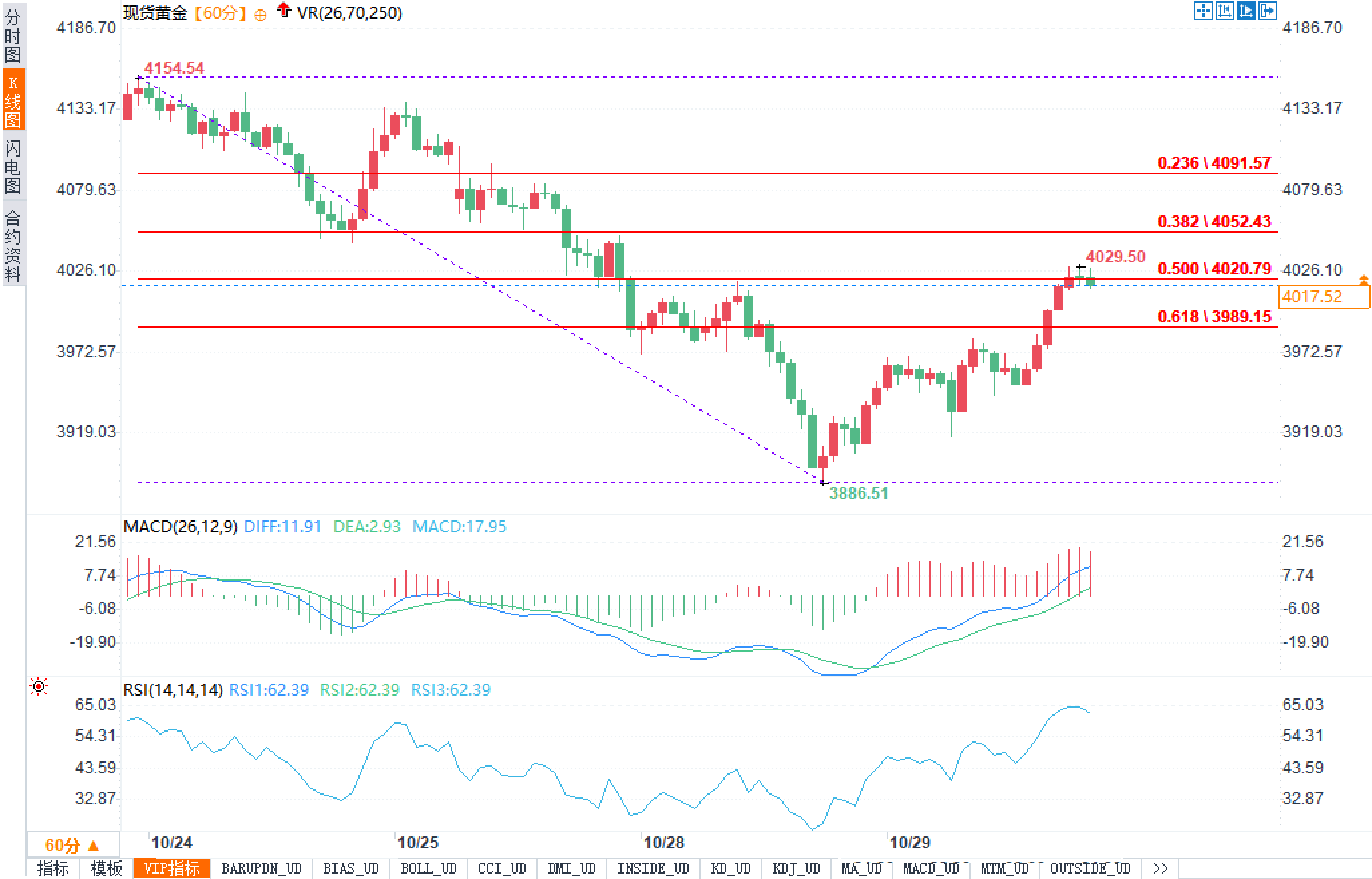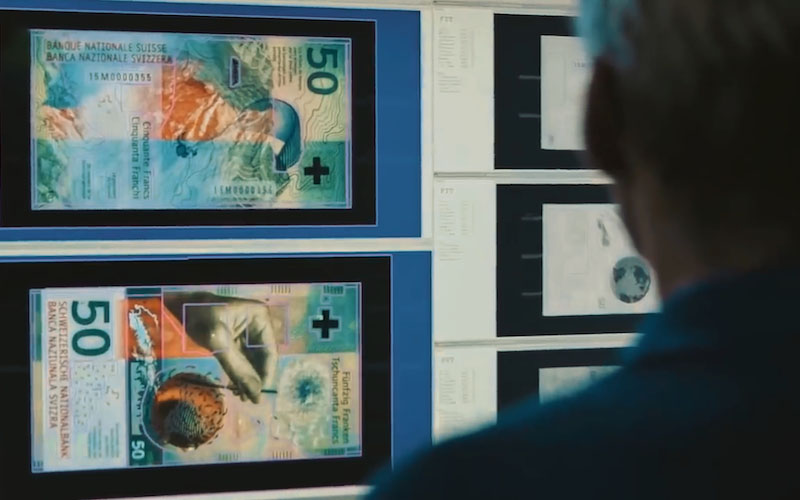Gold's life-or-death situation: Powell may "blindly cut" by 25 basis points, traders are closely watching the 0.5 retracement.
2025-10-29 20:35:37

Fundamentals: Interest rate cuts are a foregone conclusion, but guidance may be "cautious."
The lack of key macroeconomic data due to the government shutdown this month means the Federal Reserve will hold its meeting under conditions of "incomplete information." However, the core message remains unchanged—the market has almost fully priced in a 25 basis point rate cut in October in futures trading, and the target range for the federal funds rate is expected to be lowered to 3.75%-4.00%.
Looking at the "second-tier data," US economic activity remains resilient (supported by the PMI and an estimated 3.9% annualized real-time GDP growth), while the labor market shows signs of marginal cooling (private sector employment changed by -32,000 in September). This combination of measures provides a narrative framework for a "risk-management-style easing" approach to the October rate cut.
The market's bets on the subsequent path are more crucial – currently, the market generally bets on two more cuts this year (one in October and one in December). However, in the absence of key data, the Fed Chair is more likely to avoid making any pre-commitments regarding December at the press conference; if the remarks are cautious and emphasize that "it still depends on the data," it may limit the market's imagination for a continued dovish stance in the short term.
In addition, the timeline for quantitative tightening (QT) became another underlying theme of this meeting. If it is announced that QT will end sooner or be completed in November or December, it will lower term premiums and long-term yields, which will be beneficial to gold; if QT is continued and a more neutral statement is given on the balance sheet, the positive effect will be diluted.
It is worth noting that the US dollar index strengthened moderately to around 99.00 before the meeting, and the 10-year yield approached 4.00, both of which put upward pressure on non-interest-bearing assets. However, once the forward guidance after the meeting points to a consensus of "continuing to cut interest rates this year," gold's sensitivity to real interest rates will once again dominate the market.
Technical aspects:
Observing the 60-minute chart, gold prices previously declined from a high of 4154.54 along a downward slope, reaching a low of 3886.51 before forming a V-shaped rebound. During the rebound, Fibonacci retracement levels formed a clear "stepped resistance-support" system.
The 0.618 retracement level is at 3989.15, which is the first line of defense for the bulls during a pullback.
The 0.500 Fibonacci retracement level is at 4020.79, and the current price is hovering around this level; the short-term high is seen at 4029.50.
The 0.382 Fibonacci retracement level is at 4052.43; a break and hold above this level would target the 0.236 Fibonacci retracement level at 4091.57.
The dense trading volume and historical resistance levels above are concentrated around 4130, forming a "strong resistance zone" with the previous high of 4154.54.

In terms of momentum indicators, the DIFF of MACD (26,12,9) has crossed above the DEA, and the histogram continues to expand, indicating that the momentum after the volume breakout is still being released; RSI (14) is near 62.39, has not yet entered overbought territory, and has room for upward movement. Overall, the downtrend line has been broken upward, and the market is in a technical rebound phase. If 4020.79 is effectively converted into support, the price is expected to advance step by step towards 4052.43 and 4091.57; if it falls back below 4020 and breaks below 3989.15, then we need to be wary of a pullback to the 3972-3910 range, and a deep pullback may retest 3886.51.
Market sentiment observation:
The pre-meeting narrative exhibited a "scissors" effect—on the one hand, the market consensus on "two rate cuts this year" remained unchanged; on the other hand, the dollar and yields rose slightly in tandem, reflecting a defensive pricing strategy based on the chairman's "no pre-commitment." This misalignment of "rate cut expectations + cautious guidance" essentially amplifies volatility.
If the post-meeting statement and press conference emphasize that "economic resilience remains and path-dependent data persists," the US dollar may remain stable, and the upward movement of gold will be suppressed by dynamic resistance. However, if real interest rates fall due to expectations of interest rate cuts, the decline will also be limited.
If a clearer signal of "ending as soon as possible" is given regarding QT, the term spread and real yield will both decline, and gold will gain elasticity through a combination of volume and price movement.
Market Outlook:
1) Short-term scenario (next 1-3 days)
Bullish Path: If the Fed's stance aligns with market consensus and provides a clearer dovish signal regarding the QT closing time, the price target is first 4052.43, then 4091.57; if the momentum continues and the RSI "strong zone" becomes less pronounced, an upward breakout test of the 4130-4154 resistance zone cannot be ruled out.
Bearish Path: If the chairman clearly avoids looking ahead to a December rate cut, or if USD/USD Treasury bonds interpret the post-meeting statement in a hawkish manner, and gold prices fall below 4020 and 3989.15, then it will enter a period of repeated fluctuations along the lower edge of a horizontal channel, with the 3970 area becoming a key support level. Further retracement would open up the 3940-3910 range, and a sharp drop would require monitoring the 3886.51 level as a potential "support-turned-resistance test".
2) Medium-term bullish scenario: If the rate cut in December becomes a reality, and the QT is confirmed to end in November-December, coupled with other G10 central banks adopting a more dovish stance, the decline in real interest rates will drive gold to switch from a "rebound" to an "uptrend"; in terms of price structure, the key rhythm of breaking through 4091.57, pulling back, and then breaking through again will become the key rhythm for the continuation of the trend.
Bearish version: If inflation rebounds or the labor market tightens again, causing the market consensus of "two rate cuts this year" to be downgraded to "one", the dollar and long-term interest rates will rise, and gold will return to below the upper edge of the downward channel. The consolidation market, which is trading time for space, will be prolonged, and the 4052-4092 range will evolve into a "strong resistance box", which will be difficult to hold after multiple attempts to break through.
Key level summary:
Support levels: 3989.15, 3972.57, 3910, 3886.51
Resistance levels: 4052.43, 4091.57, 4130, 4154.54
Note: The significance of comparing institutional viewpoints: Multiple Wall Street institutions are converging on the main theme of this interest rate meeting—a 25bp rate cut in October is almost a certainty, with a high market consensus on another cut in December; the differences lie in the end date of QT and whether the chairman will provide clear forward guidance. For gold, the uncertainty of the path is more likely to drive volatility than a single rate cut itself.
Clear signals (such as an earlier QT contract) → Reduced term premium → Bullish for gold prices;
Cautious tone (avoiding commitment to December) → Dollar and yields stabilize in the short term → suppressing gold prices;
The combination of these two factors (interest rate cut + caution) leads to a price consolidation within a range, with technical factors taking precedence. The key focus should be on the success or failure of the 4020.79 level and the resonance between MACD and RSI.
- Risk Warning and Disclaimer
- The market involves risk, and trading may not be suitable for all investors. This article is for reference only and does not constitute personal investment advice, nor does it take into account certain users’ specific investment objectives, financial situation, or other needs. Any investment decisions made based on this information are at your own risk.





















